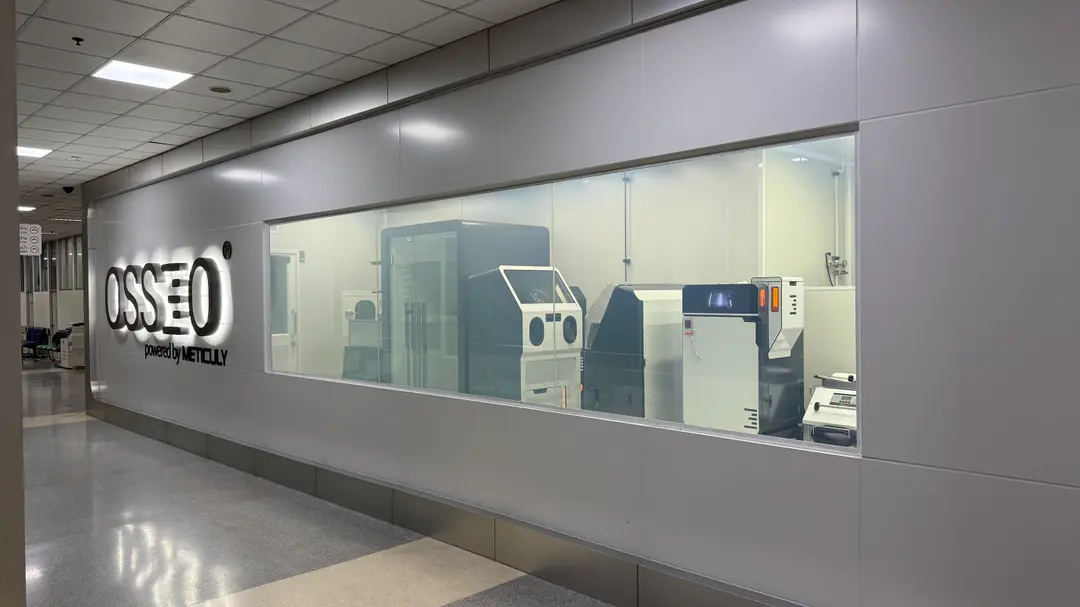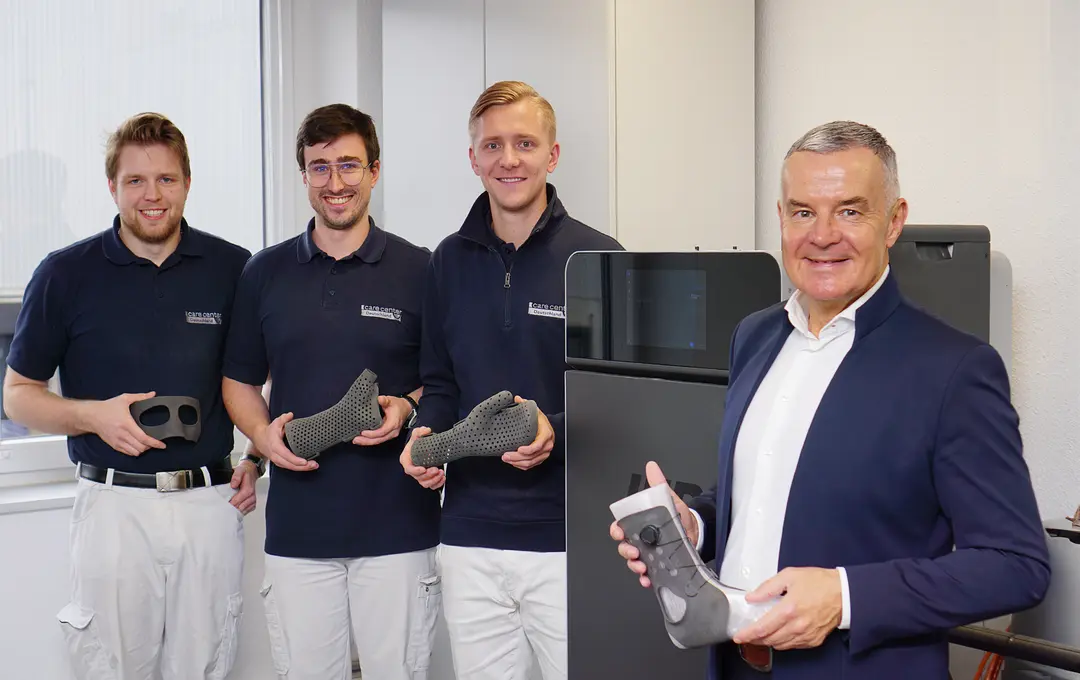RICOH 3D for Healthcare aims to democratize access to patient-specific medical devices by bringing 3D printing to enterprise healthcare systems. 3D printing models for surgery can save an average of $3,720 per case1, yet hospitals face numerous challenges in establishing in-house 3D print labs. These include patient data sensitivity (HIPAA), securing specialized talent for medical image segmentation and printing, building a robust quality management systems for reproducibility and accuracy, and navigating uncertain regulatory clearances from the FDA for in-house production. RICOH 3D for Healthcare directly addresses these pain points.
“We’re trying to get these technological advancements in the hands of surgeons that treat the majority of Americans every day because we really do believe in the better patient outcomes that come from patient-specific medical devices.”
Ryan Hess, Senior Director, Innovation and Strategy, RICOH 3D for Healthcare
One way to think of these centers is as an onsite bespoke manufacturer, with the key differentiator being the strict regulatory requirements for the design and production of medical devices. RICOH 3D for Healthcare’s centers are for large health care providers who have distributed health networks across a broad geographic area, providing resources across both urban and rural areas.
Brian Overshiner manages the Winston-Salem, North Carolina center. Located at Atrium Health Wake Forest Baptist, the center can both tie into the innovation of Advocate / Atrium Healthcare, an enterprise healthcare system, and serve as the entry point for RICOH 3D for Heathcare’s services to cover 67 hospitals across the broader six state network within Advocate Health.
Centers can start small, with an expert and a single printer ecosystem, scaling up as adoption and demand increases within the hospital system. Meanwhile, other sites can support any needs that arise that cannot be met by the center alone.
“The smallest possible footprint of the resources that we include would be an expert like Brian and a Formlabs printer.”
Ryan Hess, Senior Director, Innovation and Strategy, RICOH 3D for Healthcare
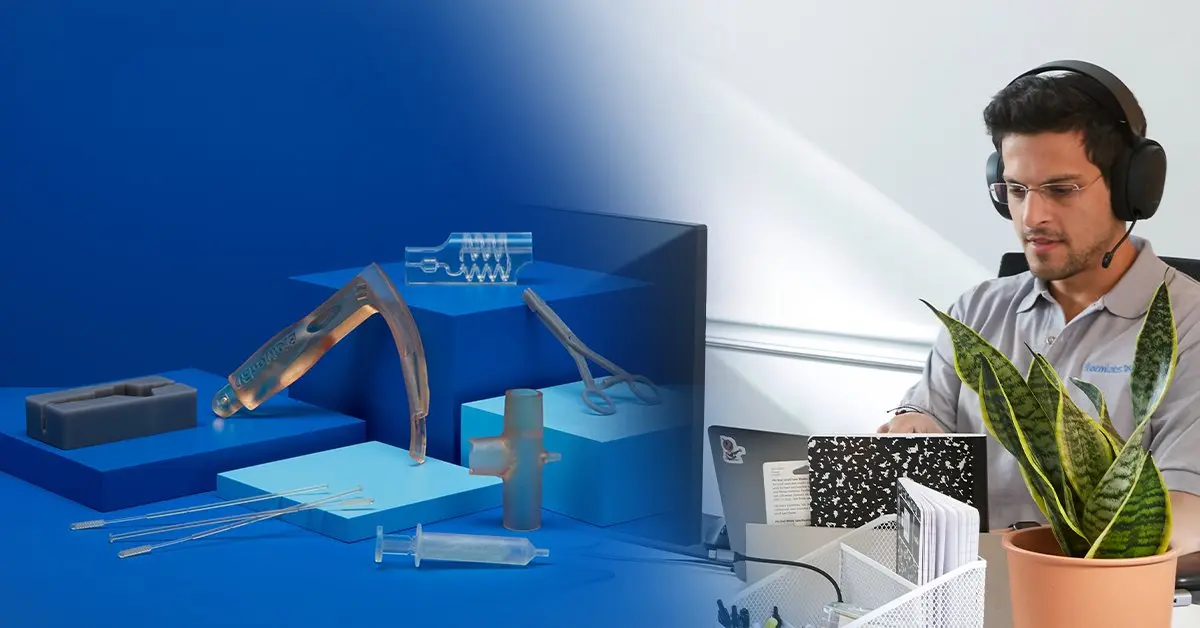
Talk to Our Experts
Whether you need to make patient-matched surgical tools or high-fidelity biocompatible prototypes for a medical device, we’re here to help. Contact our 3D printing experts to find the right solution for you and your company's needs.
Lowering the Barrier to Entry
Setting up a lab can be difficult. Overshiner says that accessing technology can be the first barrier for an enterprise system that wants to invest in a program, “you can make some wrong decisions which can really set you back, and you could waste a lot of money that way.”
Choosing printers and software to purchase, navigating IT and Security departments, creating SOPs and hazardous material management plans, formulating reliable training and education, deciding who is going to run the machines, service the machines, clean the machines, maintain the facility and implement a quality management system…setting up a lab requires expertise. RICOH provides this — from technology selection and start-up to the modelling and expertly trained production staff.
Ryan Hess, Senior Director of Innovation and Strategy at RICOH 3D for Healthcare says, “Some of our customers already have a well-educated surgical team who understand the applications both for anatomic modeling as well as cutting guides. Similarly, some have radiation oncology clinicians who demand patient-specific devices like bolus, bite blocks, and brachytherapy applicators. These sites quickly tap into the ROI of RICOH’s design resources, biomedical engineering, and production resources that can handle high volumes and fast turnaround times.
Other sites that are in the early development phase are designed around the resources and support they need to get started — sometimes a single 3D printer ecosystem and expert. RICOH will then work collaboratively with the institution on education and outreach about the appropriateness criteria of specific complex cases, where the benefits have been rigorously documented, creating those internal business cases needed for acceptance. Then they scale that footprint as adoption increases, relying on other RICOH 3D for Health centers for the production of any devices that might be required. Hess says that “For those customers, one of the most important things would be your design capabilities and expertise (design resource). What we've seen at the point of care is that how you really get adoption to change is that person who can engage the surgeon and has expertise to be able to say, “that's a very interesting case, I think there's a lot of applicability here, let's work on getting that case done together.” Suddenly, you have a new champion.”
“We can scale to the needs of the customer, so that the barrier of entry is a lot lower. If we start with one Form 4B, and notice that it's taking us all day to produce eight models and we have 20 models a week, we need another machine ASAP to handle that volume. You get complete customization from RICOH, which is super valuable.”
Brian Overshiner, Manager, Center of Excellence Healthcare, RICOH 3D for Healthcare
Quality Management Systems & Regulatory Risk
“Diagnostic models are class II medical devices. Doctors are making clinical decisions based upon a 3D print. That's why it's so important to have our clearances, to have our quality management system in place to make sure that these are accurate when we hand them over to the surgeon, because millimeters do matter.”
Brian Overshiner, Manager, Center of Excellence Healthcare, RICOH 3D for Healthcare
Navigating regulatory risk and FDA guidelines is a complex process for point-of-care facilities.
“We're playing our part by saying, "Okay, this is a way for you to have the on-site presence that you're looking for in establishing your own site, but still abiding by all of those FDA medical device manufacturing requirements.”
Ryan Hess, Senior Director, Innovation and Strategy, RICOH 3D for Healthcare
RICOH 3D for Healthcare has 510k clearance on anatomic modeling from the U.S. Food and Drug Administration (FDA), which covers a very broad indication for use across most of the entire body. These are registered medical devices that RICOH is producing at the point of care across service lines, including cardiology, orthopedics, oncology, and more. Additionally, RICOH is the authorized distributer of other 510K cleared patient-specific medical devices such as osteotomy guides and bite blocks that customers require. Similarly, RICOH’s internal R&D has ongoing development of a broad array of future patient-specific medical device products. Because RICOH 3D for Healthcare is using 510K cleared processes including a Quality Management System, the enterprise healthcare systems themselves don’t have to go through the process of obtaining 510K clearances, saving valuable time and resources.
“RICOH is spearheading the model of what medical device production should be with 3D printing in a hospital setting. We're prepared for the day that the FDA provides laws. We’re standardizing how 3D printing fits into current surgeons’ workflows.”
Brian Overshiner, Manager, Center of Excellence Healthcare, RICOH 3D for Healthcare
The Technology

3D printers inside the Innovation Studio include Formlabs Form 3B+ 3D printers. (Photo: RICOH 3D for Heathcare)
RICOH is technology agnostic, allowing them to offer a full spectrum of technology at their locations and leaving the door open to innovation. Which 3D printers are installed at a location is tailored to the customer and may include:
-
Material jetting / PolyJet
-
Stereolithography (SLA)
-
Selective laser sintering (SLS)
-
Fused filament fabrication (FFF)
Part of Overshiner’s job is determining what printing technology is best suited to the needs of a doctor, and how many printers are required when starting a lab. Often, a lab can start with a single Formlabs Form 4B SLA 3D printer and an expert.
SLA & SLS: Formlabs 3D Printers
For their SLA ecosystems, RICOH 3D for Healthcare relies on Formlabs Form 4B desktop 3D printer and Form 4BL for large-format printing. For SLS, RICOH 3D for Healthcare utilizes Formlabs Fuse 1+ 30W for radiation oncology solutions.
“When people come through our lab and they're asking questions about the printers, I say about Formlabs, ‘these are the ones that just work.’ That's very important when you start these point of care labs for a hospital because you don't want to be troubleshooting all day.”
Brian Overshiner, Manager, Center of Excellence Healthcare, RICOH 3D for Healthcare
Print accuracy is paramount for medical applications, where every millimeter matters. Form 4B/BL delivers ±0.15% dimensional tolerances for highly accurate parts. Timelines, too, are important in a fast-paced environment or for potential rushed cases. Form 4B enables the quick turnaround of emergent cases and, with 98.7% print reliability when tested by an independent third party, delivers reliable production, minimizing the time and resin costs associated with reprinting.
“Formlabs delivers the best customer engagement that we've had in the AM industry and all of that at a price point that makes it really agile for us to be able to fit it into new products. You're getting such a high value at really reasonable prices. It’s got both the support you need and the scale for consistent delivery of product when you need it.”
Ryan Hess, Senior Director, Innovation and Strategy, RICOH 3D for Healthcare
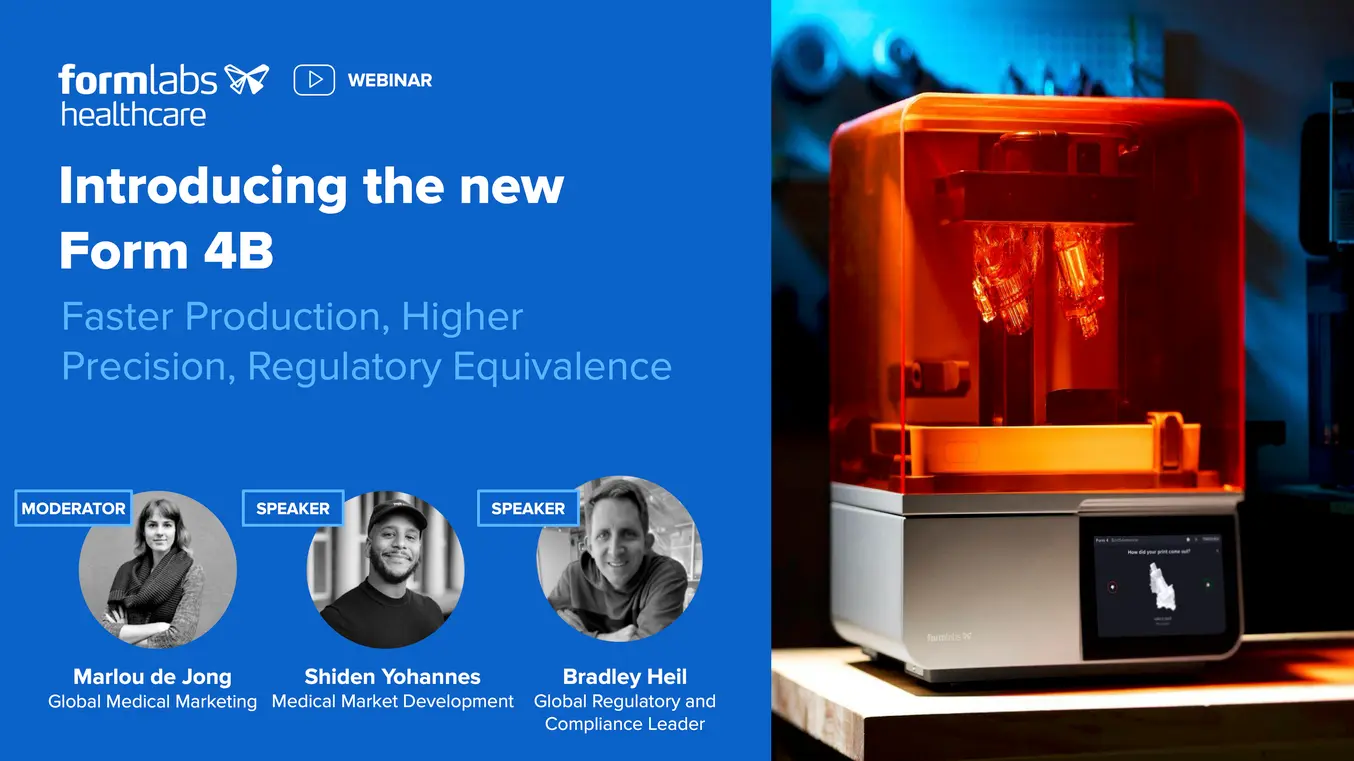
Introducing Form 4B: Faster Production, Higher Precision, Regulatory Equivalence
Join Formlabs for an exclusive look at the Form 4B & how it boosts production, achieves unmatched accuracy, and integrates smoothly (regulatory equivalency explained).
Material Selection
“Formlabs has a really great ecosystem and a robust materials library.”
Brian Overshiner, Manager, Center of Excellence Healthcare, RICOH 3D for Healthcare
RICOH 3D for Healthcare prints with materials that have been cleared to use in RICOH’s 510ks. At a center, selecting the 3D printing technology and material for a job then comes down to time and cost. For example, printing a bone that doesn't need to be multicolor or clear, Overshiner may select standard ABS on an FFF printer as it is economical. If a faster turnaround time is needed, Overshiner says he “might shift over to Formlabs because your new Form 4Bs can print at lightning speed, which is amazing.”
| Printer | Materials | Applications |
|---|---|---|
| Form 3B+/BL | BioMed White Resin V4 BioMed Clear Resin V4 | Craniomaxillofacial Orthopedic Cardiovascular Neurological Genitourinary Gastrointestinal Breast |
| Form 4B/BL | BioMed White Resin V5 Clear Resin V5 BioMed Flexible 80A Resin V1 | Craniomaxillofacial Orthopedic Cardiovascular Neurological Genitourinary Gastrointestinal Breast |
For physicians less familiar with 3D printing, Overshiner may print a couple of models so that they can see the different materials and understand the range of potential, from multicolor to clear to flexible.
Devices with 510Ks are printed in their approved materials, but when developing new devices, RICOH can experiment with different materials. Hess says that, during development, a specific material may come to mind, but that selection ultimately comes down to diving into material characterization and product requirements.
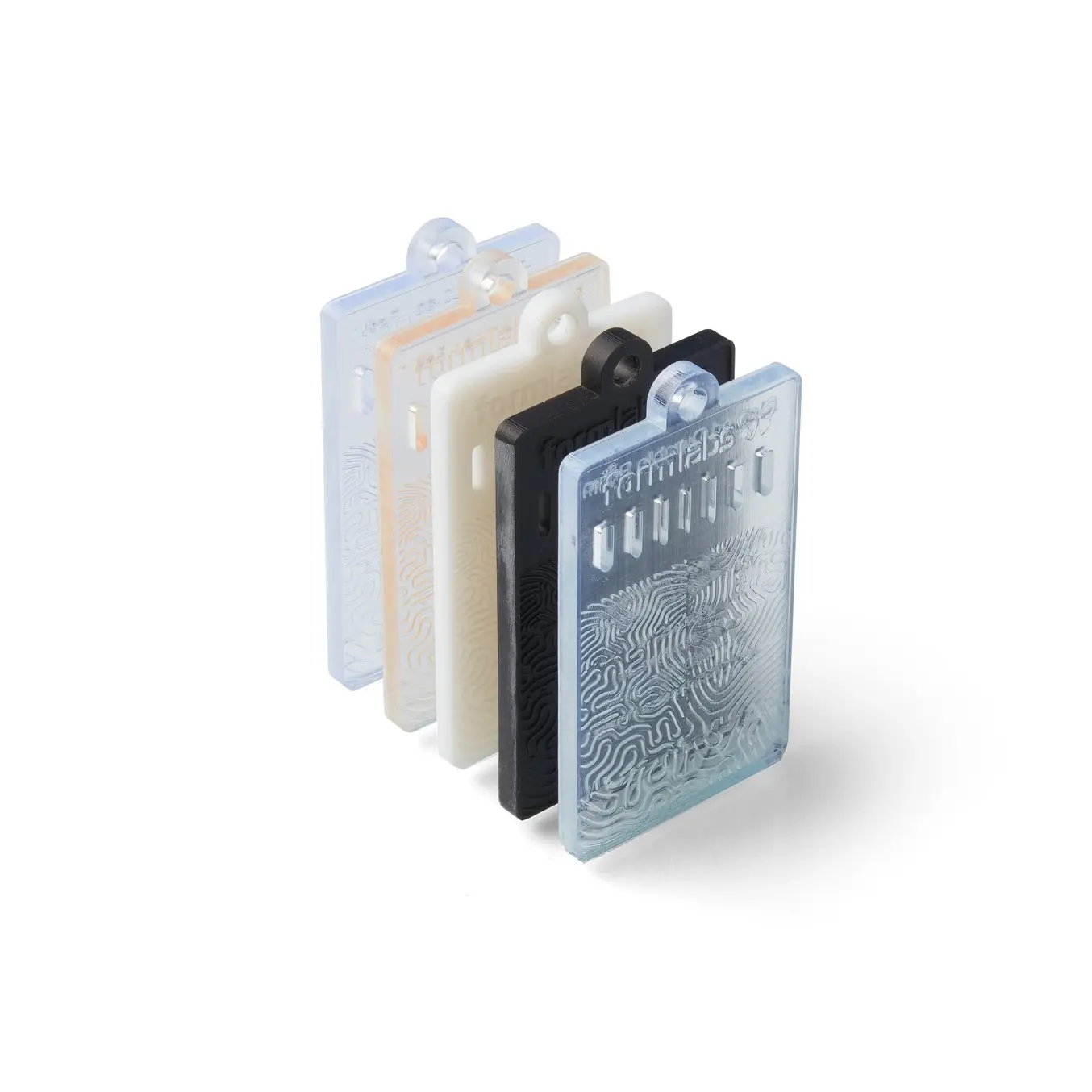
BioMed Resin Swatches
Each BioMed Resin swatch features embossed and debossed designs, 0.5-2.0 mm cutout thicknesses, as well as regulatory information unique to that resin.
Distributed Manufacturing Networks: Scalability & Return on Investment
“Each site is not specific to that customer — we look at these as a part of a distributed manufacturing network that is designed to be agile and handle volumes as they ebb and flow across the whole network. The same would be said for the expertise around biomedical engineering.”
Ryan Hess, Senior Director, Innovation and Strategy, RICOH 3D for Healthcare
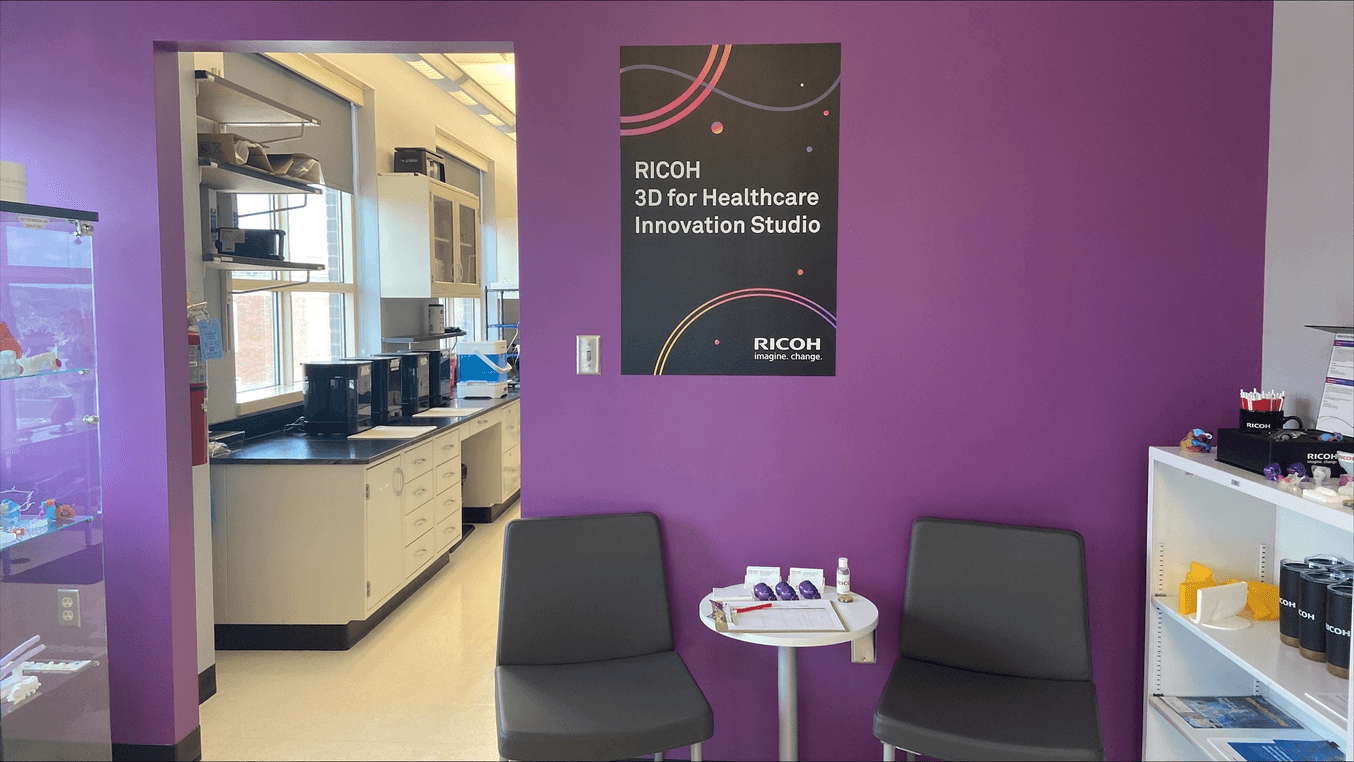
The RICOH 3D for Healthcare Innovation Studio at Atrium Health. (Photo: RICOH 3D for Heathcare)
For example, Overshiner will handle the most urgent needs that Advocate Atrium has on a given day. But the systems are designed so that the rest of the team can do production work and ship it to the site, or design and send the files back to Overshiner. This distribution model supports scalability but also mitigates risk — ROI is considered across the entire network and not just one location, making it easier to start and scale a new center.
Centers have their own core competencies, as well. By way of example, Hess explains that a hospital might start with cardiology, with a design resource who has expertise in cardiology who’s there to work with the surgeon. If this hospital then expanded into orthopedics, they could rely on the expert at another location for highly technical questions. By doing this, each location has access to a network of experts and printers.
Experts by Your Side
You can have the most cutting-edge technology, but having an expert by your side makes all the difference. For RICOH 3D for Healthcare, Overshiner is that expert. His role goes beyond managing the center to training and education, working with surgeons to provide information and education.
Standardization goes hand in hand with education. “We want to be invisible to the whole process.” Overshiner says. “With our customer management portal and our PACS-Print Gateway for imaging, it's a literal click of a button, and the model will go from production, to delivery, to the surgeon. We can do this seamlessly so it doesn’t interrupt workflows.”
In addition to growing the number of centers around the USA, Hess says, “Our goals are to continue to expand the types and quantities of patient-specific medical devices that are reaching health care providers in the United States. We are looking at a lot of collaborations with other manufacturers who have significant innovation in the space.” Beyond manufacturers, Hess is tapping into the specialties of those closer to home. “All of the surgeons are very creative and brilliant individuals who are thinking innovatively.”
Ultimately, RICOH 3D for Healthcare is working to lower the barriers to adoption of 3D printing at point-of-care — and Formlabs 3D printers are playing a role in that. Explore Form 4 Series 3D printers, learn more about regulatory affairs and quality assurance (RAQA), or contact sales to learn more.
1. American Radiology, Volume 27, Issue 8. Medical 3D Printing Cost-Savings in Orthopedic and Maxillofacial Surgery: Cost Analysis of Operating Room Time Saved with 3D Printed Anatomic Models and Surgical Guides. August 2020.
